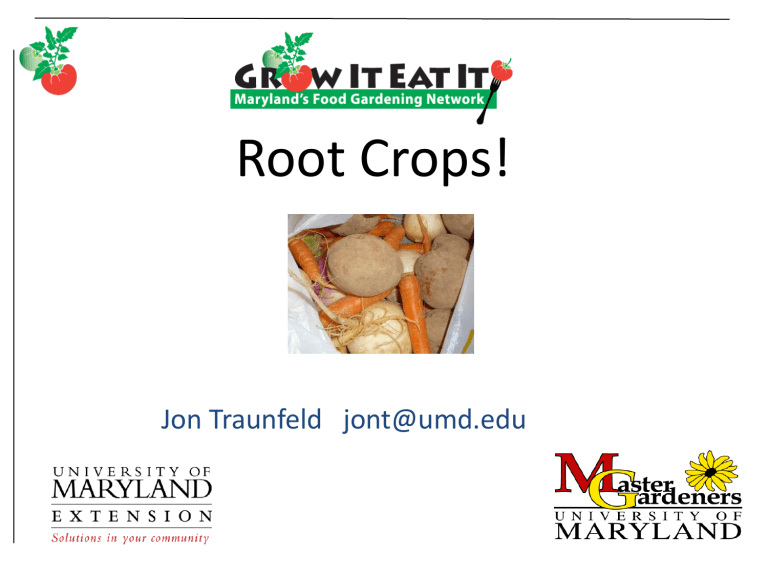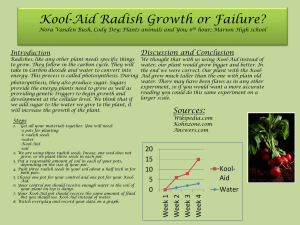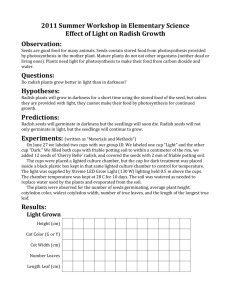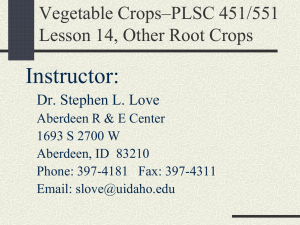Root Crops - University of Maryland Extension

Root Crops!
Jon Traunfeld jont@umd.edu
College of
Agriculture and
Natural Resources
Reasons to grow root crops
• Some are double-duty crops…eat tops and roots: beet, sweet potato, radish, celeriac, onion, leek, garlic, turnip
• Many are cool season crops- can be grown in spring and fall
• Most are storage crops that can feed you yearround!
Tips for success
• Need at least 8-in. of loose, fertile soil (carrots and parsnips will do better with 12 inches.
• Push garden fork into the soil and rock it back and forth to loosen subsoil. Then add compost and mix in with topsoil.
• Cover seedlings with floating row cover to speed up growth and protect plants from pests.
• Thin out seedlings so that you end up with the correct spacing between plants.
Cold tolerance of common root crops
• Hardy (can tolerate heavy frost)- garlic, leek, multiplier onion, turnip, radish
• Half-hardy (can tolerate light frost)- beet, carrot, parsnip, rutabaga
• Half-tender (frost injures plant)- potato
• Tender (frost will kill plant)- sweet potato
• Can overwinter in garden- garlic, leek, multiplier onion, carrot, turnip, radish (daikon will begin to decompose by mid-winter)
Spring planting
• Read and plan- seed catalogs, seed packets, plant date charts.
• Radish, beet, carrot, turnip, onion can be planted 4-6 weeks before last expected frost.
• Plant every two weeks if you like the crop!
• Hold off on planting potato until soil warms
(mid-April)
Pre-germinating seeds
• Works well for slow-growing seeds like beet and carrot.
• Gives plants a head start.
• Soak seeds overnight in water or in a moistened paper towel enclosed in a plastic bag.
Fall planting
• Vegetables take longer to mature.
• Cool nights slow plant growth.
• Days grow shorter, less sunlight energy for plants.
• These environmental conditions cause conversion of starch to sugar.
Short-day factor for fall planting.
• First frost date for your area
• Days to maturity, germination, transplant
• Add 14 days for Short Day Factor
Formula:
Days to maturity + Days to germinate + Days to transplant + SDF=Days to plant before frost
Sample calculation for sowing turnip seeds
• Days to germination: 4-7
• Days to maturity: 50-55
• Short Day Factor (SDF): __14__
68 - 76
I can sow seeds between 68 and 76 days before the first frost – about Oct. 20 for Ellicott City.
Counting back from Oct. 20 the dates to sow are about
Aug. 1 to August 13.
Sowing seeds for fall crops
• Soil is hot and dry.
• Clay soil forms hard crust.
• Seeds need cooler temperatures and moisture to germinate and grow.
• Slow growing beets and carrots will suffer setbacks if soil is dry.
Tips for sowing seeds in summer
• Water soil before sowing.
• Sow in the late afternoon so germination will begin overnight.
• Plant seeds slightly deeper than in spring.
• Can cover seeds in furrow with potting soil or vermiculite.
• Keep soil cool and moist. Cover seeded area with burlap, newspapers, boards, or light mulch.
Floating Row Covers
• First line of defense against frost- spring or fall
• Hastens germination
• Protection for tender plants/seedlings from heat/sun
• Excludes pests
• ‘Hold-ups’ (support); examples: pvc pipe, reinforcing wire, and nine gauge wire few; be creative!
Interplant- spring or fall
• Use shade from existing plants.
• Sow fast growing greens between slower growing root crops.
• Plant a row of carrot and then plant radishes in a parallel row 3 inches from the carrots. Radish germinates more quickly, will help mark the carrot row and will be harvested by the time the carrots need extra room.
Tips for effective use of cold frames
• Wetter isn't better: allow soil to become nearly dry to encourage deep roots
• Don’t be mean…lean: no footsteps inside; lean in or install stepping boards
• Survive a freeze, you’ll be pleased: throw a blanket or old carpet on top to retain heat
• High/low will show: place a high/low thermometer for easy monitoring
Cold frames must be vented to let hot air out on sunny days!
Garlic- # 1 fall crop!
• Purchase bulbs to plant in October from a seed/plant company; not from grocery store!
• Choose full sun location
• Weed area and amend soil with compost
• Separate cloves and plant them pointed end up, 2 inches deep and 5 inches apart
19
• Top dress with compost or mulch to deter weeds
• In spring add fresh layer of compost or mulch
• Remove and eat flower stalks
(scapes) to insure large bulbs
• Harvest late June-early July
20
Gently dig up bulbs with garden fork.
Cure bulbs on porch or wellventilated room. Lay plants on window screen or hang them. Cut tops off after 2-3 weeks and store in dry cool location
.
Beets come in different colors and sizes; baby beets can be grown in containers.
Potato seed pieces are cut and planted
8-12 inches apart in tranches at this
UME Master Gardener demonstration garden in Montgomery Co.
Vole feeding can be prevented with snap traps, live traps (above) or tight mesh fencing.
Parsnips are delicious and underutilized in most home gardens and kitchens. Seeds are are slow to germinate.
Turnip and carrot are two fabulous crops to roast in the oven.
• Radish is a great beginner cropfast and easy.
• Top right is a forage radish
(edible) grown to improve soil.
• At right is a Salad Table full of healthy radish plants.
Sweet potato can tolerate hot, dry weather. The foliage is rampant and can be harvested for excellent greens- raw or cooked.
Stir-fried sweet potato roots and tops above.
Sweet potato fries are delicious!
Other root cropsceleriac
Also known as celery root. Slow-growing with soft celery flavor. Eaten raw or cooked. Leaves are also edible.
Other root crops-leek
Planted in spring and harvested fall through the following spring.
Other root crops- yacon
One of the “lost crops of the Incas”; eaten raw.
Resources
• Grow It! Eat It!
http://www.extension.umd.edu/growit
– We have all types of practical food gardening tips and information. Check out our popular blog!
• Home and Garden Information Center http://www.extension.umd.edu/hgic
– Here you will find factsheets, photos, and videos. You can also subscribe to the free monthly e-newsletter.
– We answer gardening questions 24/7…just click
“Ask Maryland’s Garden Experts”
• Maryland Master Gardener Program http://www.extension.umd.edu/mg
– Consider becoming a trained MG volunteer!
Many thanks to Grow It Eat It bloggers and
Calvert County MGs who provided photos and information:
Erica Smith (head blogger), Nancy Robson, Kent
Phillips, Nick Tardiff, Lena Rotenberg, Butch
Willard, Sabine Harvey, Bob Nixon
Powerpoint by Jon Traunfeld, Extension Specialist;
March, 2013
This program was brought to you by the
Maryland Master Gardener Program
Howard County
University of Maryland Extension











